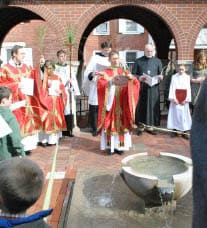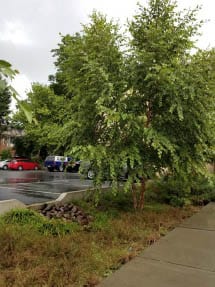By John Hershey, RGS Associates and Ruth Ayn Hocker, Manager, Bureaus of Stormwater and Wastewater Collections, City of Lancaster
Two historic churches in Lancaster, Pennsylvania demonstrate how a sacred place can be maximized as a civic asset that advances the vitality and environmental health of the larger community. Saint James Episcopal Church and Community Mennonite Church are both serving their respective congregations while simultaneously providing their neighbors with social and environmental benefits.

Palm Sunday procession starting in the newly-constructed courtyard
Photo: St. James Episcopal Church
Established in 1744, Saint James Episcopal Church recently developed a master plan that prioritized facility needs, including a more welcoming approach to the building, expanded interior and exterior gathering spaces, and greater accessibility to all facilities. To accomplish these goals, a building addition and new courtyards were constructed in 2012, with a “green” infrastructure that captures storm water runoff from the expanded structure.
Because Lancaster City is located within the Chesapeake Bay Watershed, city fathers adopted measures established by the U.S. Environmental Protection Agency, the U.S. Department of Justice, and the Pennsylvania Department of Environmental Protection to reduce and ultimately end the discharge of untreated sewage and other pollutants into local waterways via aging storm infrastructure. Even before these measures were adopted, a team of church leaders, the City’s progressive administration, and local design professionals began to proactively address these same clean water challenges.
Saint James, along with its consultants and contractors—RGS Associates, MM Architects, and Warfel Construction—implemented master plan goals while also demonstrating environmental stewardship. For example, even though its cloistered courtyard seems deceptively simple on its surface, it captures and infiltrates more than 125,300 gallons of storm water below-grade each year. In addition to new permeable paving, this courtyard incorporates recycled materials including old bricks, decorative tiles, fencing, and cast-iron window grates repurposed as gates. Most existing trees were preserved. New plants were selected from native species and heirloom varieties. A customized fountain was inspired by the church’s baptismal font. Collectively, these features achieve another key project goal: reuse and retention of the historic church’s character-defining features.
Effective resource conservation and stewardship were also key strategies for nearby Community Mennonite Church of Lancaster (CMCL). Visionary church leaders, City staff, and their design consultants worked to meet the parking needs of congregants and neighbors while adding new green infrastructure within a redesigned church parking lot. Instead of piping storm water to the Conestoga River and downstream to the Chesapeake Bay, polluted runoff from surrounding rooftops and pavement is now filtered by indigenous plantings and allowed to naturally infiltrate beneath terraced rain gardens and porous parking lot paving.

Landscaped green parking lot for Community Mennonite Church of Lancaster
Photo: RGS AssociatesPalm
This project had specific goals established jointly by CMCL and City staff. Congregational goals included preventing the loss of any existing parking spaces, enhancing the surrounding neighborhood, and providing an outdoor learning area where the science and process of creative storm water solutions could be taught. The City agreed to fund 90% of green infrastructure costs if planned site improvements could also reduce neighborhood flooding, improve water quality, and actively engage the local community. All parties reached agreement, and city funding was provided.
RGS Associates’ landscape architects and civil engineers contacted CMCL’s up-stream neighbors to observe roof drainage from their fenced yards—most of which discharged toward the church’s parking lot. To retain the required number of parking spaces while adding new plantings, CMCL decided to remove the rear portion of a vacant building near its worship place, salvaging and repurposing building materials.
Local contractors Rogele, Reliance Environmental, BR Kreider and Son, and LandStudies constructed the new green spaces, resulting in increased storm water infiltration. Presently, 87.9% of yearly rainfall is prevented from entering the City’s combined sewer system. Runoff is filtered via CMCL’s carefully tended plantings, which also provide seasonal changes in the landscape of interest to neighbors. Before this project, the neighborhood had a significant deficit of green spaces and parking spaces. Although some neighbors were skeptical of the proposed green space, many now proudly consider the greener parking area as a local park.
By creatively providing spiritual, social, and environmental benefits within their small plots of urban real estate, Saint James Episcopal Church and Community Mennonite Church have demonstrated their commitment to creation care—showing that a church parking lot can become more than a place to store cars, and that a church courtyard can become more than an outdoor gathering space. These two innovative community spaces effectively layer multiple site amenities, serve as replicable examples of sound resource stewardship, and enhance historic components of Lancaster’s religious community.

